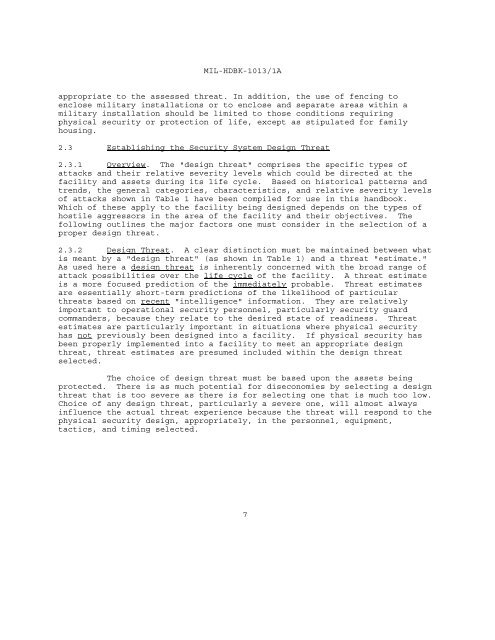MIL-HDBK-1013/1A Design Guidelines for Physical Security of ...
MIL-HDBK-1013/1A Design Guidelines for Physical Security of ...
MIL-HDBK-1013/1A Design Guidelines for Physical Security of ...
You also want an ePaper? Increase the reach of your titles
YUMPU automatically turns print PDFs into web optimized ePapers that Google loves.
<strong>MIL</strong>-<strong>HDBK</strong>-<strong>1013</strong>/<strong>1A</strong><br />
appropriate to the assessed threat. In addition, the use <strong>of</strong> fencing to<br />
enclose military installations or to enclose and separate areas within a<br />
military installation should be limited to those conditions requiring<br />
physical security or protection <strong>of</strong> life, except as stipulated <strong>for</strong> family<br />
housing.<br />
2.3 Establishing the <strong>Security</strong> System <strong>Design</strong> Threat<br />
2.3.1 Overview. The "design threat" comprises the specific types <strong>of</strong><br />
attacks and their relative severity levels which could be directed at the<br />
facility and assets during its life cycle. Based on historical patterns and<br />
trends, the general categories, characteristics, and relative severity levels<br />
<strong>of</strong> attacks shown in Table 1 have been compiled <strong>for</strong> use in this handbook.<br />
Which <strong>of</strong> these apply to the facility being designed depends on the types <strong>of</strong><br />
hostile aggressors in the area <strong>of</strong> the facility and their objectives. The<br />
following outlines the major factors one must consider in the selection <strong>of</strong> a<br />
proper design threat.<br />
2.3.2 <strong>Design</strong> Threat. A clear distinction must be maintained between what<br />
is meant by a "design threat" (as shown in Table 1) and a threat "estimate."<br />
As used here a design threat is inherently concerned with the broad range <strong>of</strong><br />
attack possibilities over the life cycle <strong>of</strong> the facility. A threat estimate<br />
is a more focused prediction <strong>of</strong> the immediately probable. Threat estimates<br />
are essentially short-term predictions <strong>of</strong> the likelihood <strong>of</strong> particular<br />
threats based on recent "intelligence" in<strong>for</strong>mation. They are relatively<br />
important to operational security personnel, particularly security guard<br />
commanders, because they relate to the desired state <strong>of</strong> readiness. Threat<br />
estimates are particularly important in situations where physical security<br />
has not previously been designed into a facility. If physical security has<br />
been properly implemented into a facility to meet an appropriate design<br />
threat, threat estimates are presumed included within the design threat<br />
selected.<br />
The choice <strong>of</strong> design threat must be based upon the assets being<br />
protected. There is as much potential <strong>for</strong> diseconomies by selecting a design<br />
threat that is too severe as there is <strong>for</strong> selecting one that is much too low.<br />
Choice <strong>of</strong> any design threat, particularly a severe one, will almost always<br />
influence the actual threat experience because the threat will respond to the<br />
physical security design, appropriately, in the personnel, equipment,<br />
tactics, and timing selected.<br />
7

















